
Introduction
It is a common practice in developing countries and some part of the world, whenever a person is bitten by a snake, the first thing that is done is to ligate (tie) the area of the bite as a first aid prior sucking out the venom with their mouth. Most times this is effective and a life saver for the victim but the danger associated with this practice outweighs the advantages of the procedure.
General overview about snakes
Snakes are generally classified as reptiles and they are the egg laying animals, cold blooded and thus always hide under rocks , Stones and in holes so as to maintain the normal physiologic and homeostatic condition of their body. Some snakes live on land while some live in water but majority spend their life on land.
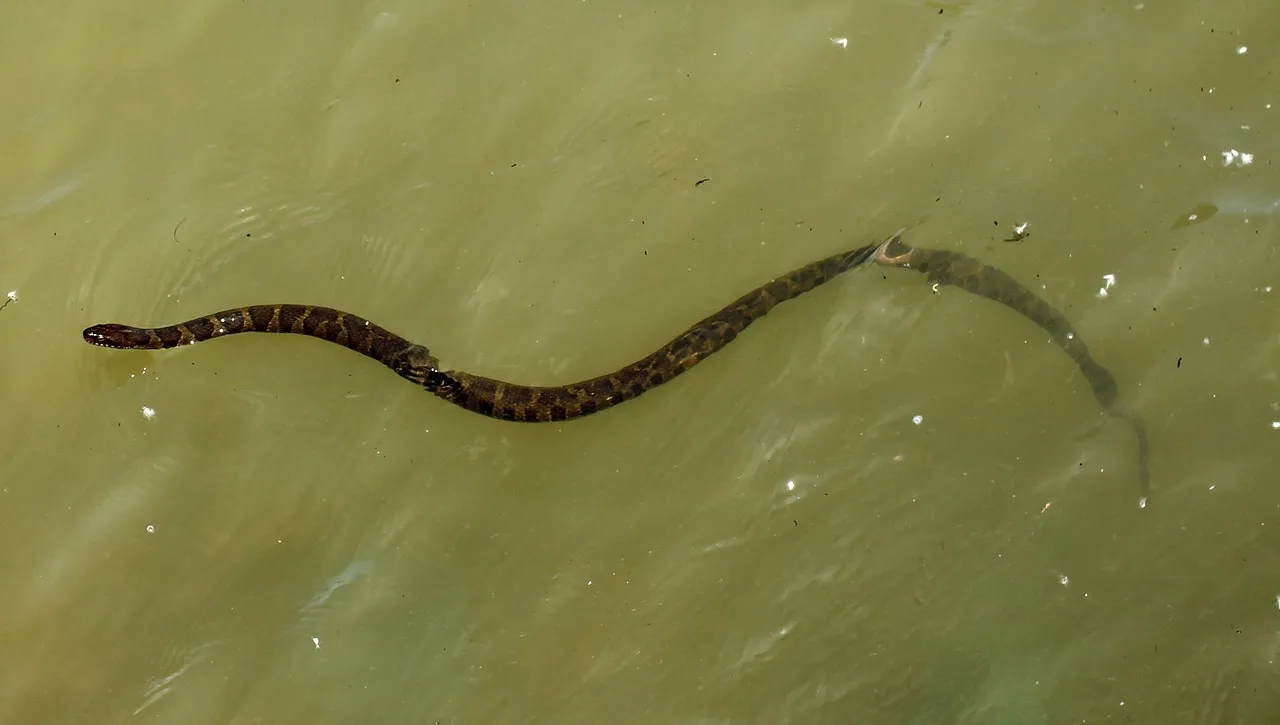
Contrary to the believe of many people, I wish to intimate you that not all snakes are venomous and thus are not harmful.
Most animals have been created in such a way that they are equipped with a very powerful defensive mechanism with which they use to feed, harm or escape the clutches of their predator when they sense danger.
There are very deadly ones like the rattle snake (it announces itself while coming due to the rattling noise made by the structure at its tail end)
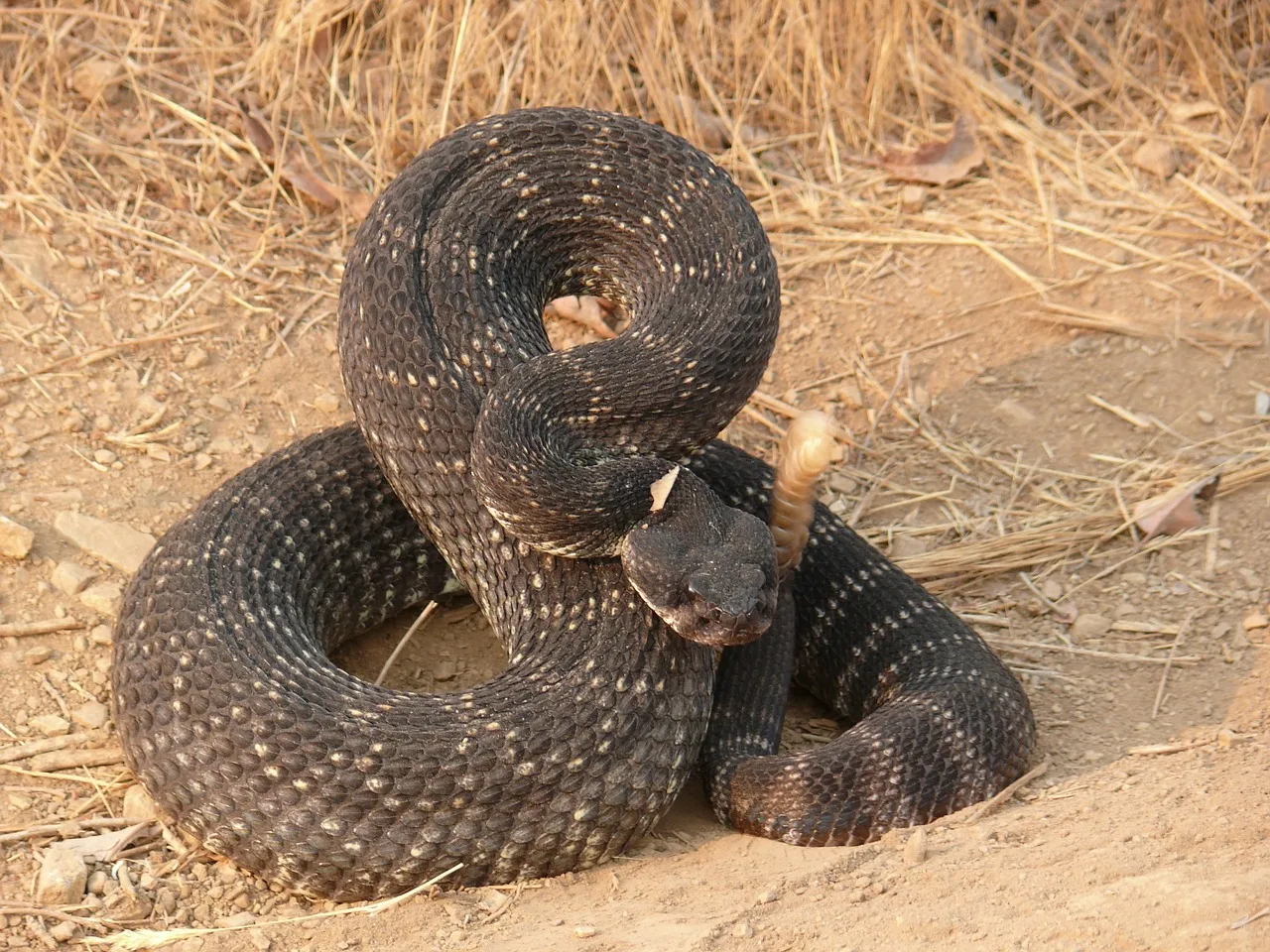
king cobra (the wise but deadly one, it can stand like a praying mantis ready to strike

Others include the vipers, death adders, the sea snakes and the black mamba . There are a whole lot of them found in several continent of the world and they all vary based on several attributes.
Snake venom
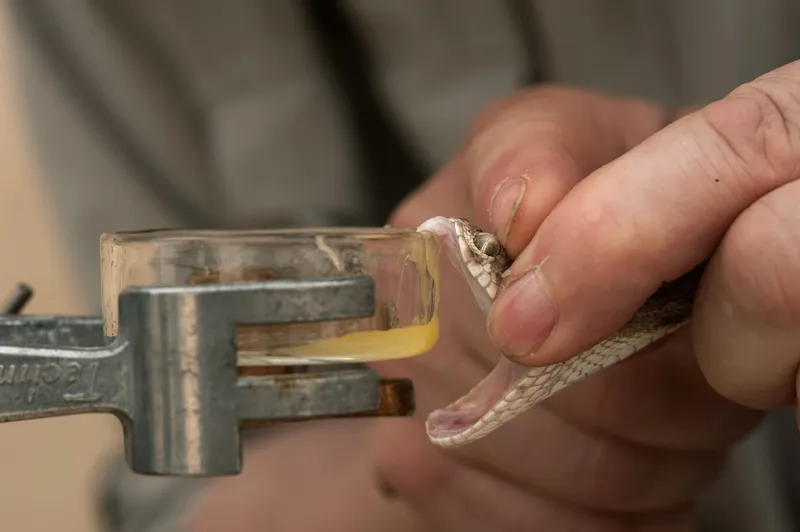
wikimedia commons image by Kalyan Varma source
It is interesting to know that, the most virulent factor and defensive machinery possessed by the harmful snake is their venomous bite aside this they are almost powerless. It can also be stated here that these venom also helps the snake to survive. They need this venom to kill their prey during feeding.
Those that don't produce venom do not most times have fangs and are able to kill by winding around their host suffocating and crushing them to death. An example is the python.
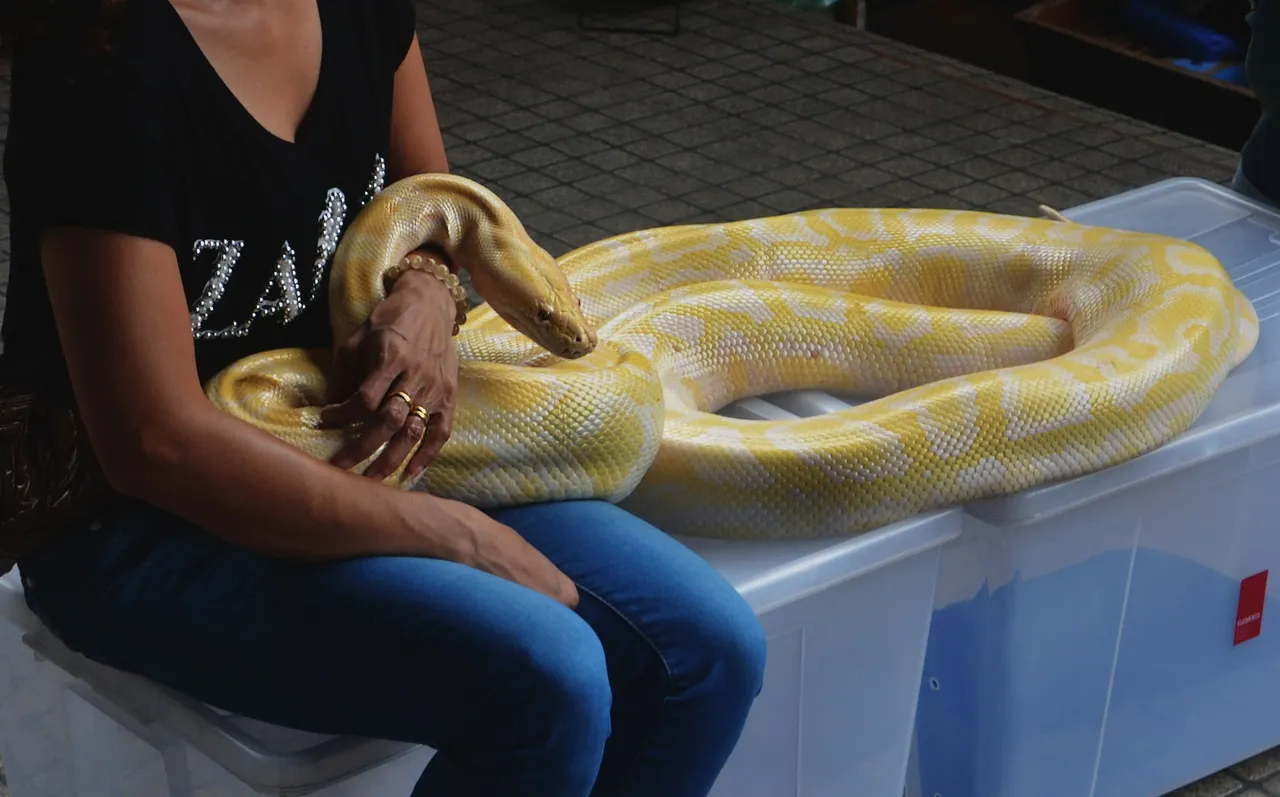
Snake Venoms are poisonous polypeptide proteins produced and secreted by venomous snakes and this venom are usually injected into their host simultaneously when they bite with their fangs.
Some snakes spit out their venom, example is the spitting cobra.
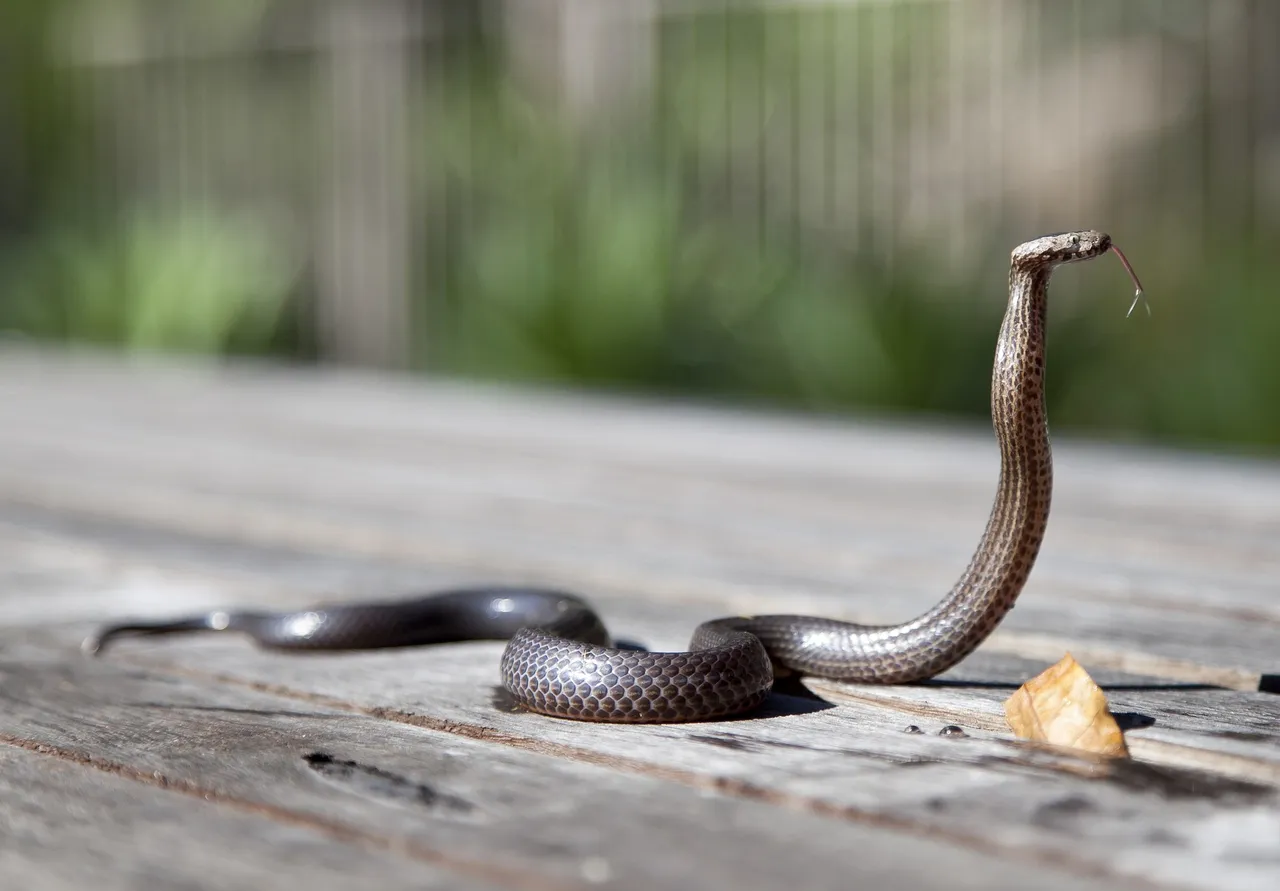
This is usually a defensive mechanism especially when they sense danger and they usually aim for the eyes of their victims. If the venom comes in contact with the cornea of the eyes it can cause blindness if not washed away immediately with plenty of water.
Mechanism of action
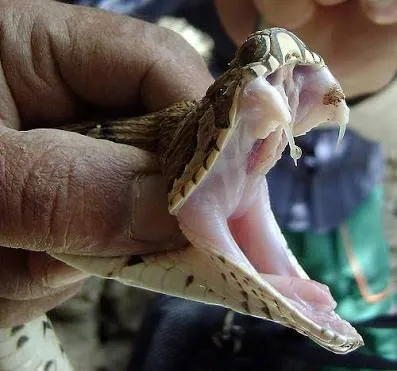
Flickr image by Usman Ahmad under CC BY-SA 2.0 source
These venom when injected elicit an immunogenic reaction in the host and thus leads to allergy or inflammation in the body of the host and around the site of bite. This is usually evident at the site of bite which is often swollen. There is also infiltration of inflammatory cells (neutrophils, eosinpphils,basophil etc) through a process known as diapedesis. Snake bite cause a lot of devastating physiologic effect on human body through there mechanism of actions and these includes :
•some contain enzymes which can either activate Hageman factor 12 of the intrinsic coagulation cascade pathway thus causing disseminated intravascular clotting or deactivate this pathway resulting to continuous bleeding at the site of bite, and this can lead to death of the victim. This is evident in rattlesnake bite.
• some produce nerve toxins that block the neuromuscular system I.e acetycholine thus leading to paralysis, this is also evident in rattle snakebite and black mambas.
•some affect the normal functions of the organs in the body like kidney, liver and heart. When important organ like the kidney is affected, acute renal failure may set in and this ultimately prevents it from carrying out its normal function of producing urine to remove wastes, causing a slow painful death if not treated. This is evident in black mamba and cobra bites.
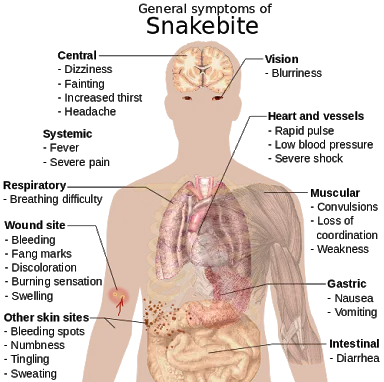
•some components of these venom cause blood vessel wall to leak and this causes fluid to accumulate in tissue thereby causing painful swelling and edema.
•some also contain peptides that mostly will activate the pain nerve receptors (nociceptors) causing local and generalised pain in the body of the victim.
•some can as well contain proteins that damages the skin, muscle and other tissues of the body resulting to destruction to the hands, legs, feels and arms.
Danger of ligating the area of bite
Haven stated all the necessary attributes and patophysiologic mechanism through which snake bite can cause deleterious effect on human, I find it safe and pertinent to now explain why ligating (tieing) the site of a snake bite need not be done.
The general feature of a snake bite be it venomous or non venomous bite is swelling at the site with two holes (a distinctive feature).
Ligating the site of bite will cause an increased pressure build up at the area under ligation so that when when you finally untie the the tourniquet used on getting to the hospital or health facility, the pressure that has already built up will force these venoms accumulated around this region faster and more quicker to the heart through the blood. This pressure will accelerate the speed at which the venom gets to the heart. If this venom gets to the heart, it will ultimately damage the muscles and consequently cause cardiac heart failures which is fatal.
Secondly, ligating the area of snake bite can cause tissue hypoxia and ischaemia ( a condition in which a tissue is deprived of oxygen and blood respectively). The ligation prevent the flow of blood to the affected area. When the muscle tissue is deprive of oxygen for a long time, this results to muscle atrophy (muscle wasting) leading to death (necrosis) of the muscle tissues. The resultant effect of this is the inability of the victim to use the area of the body affected.
Suggested actions to take before or after a snake bite
•Injection of Antivenoms
There are basically two types of antivenoms
•monovalent and
•Polyvalent anti venom
The monovalent anti venom as the name implies is usually used if one is sure of the identity of the snake that bit such person while the polyvalent is used when one is not sure of the type of the snake.
•Rather than ligating the area of bite, it is recommended to apply pressure bandage if available, this will slow down the movement of the lymphatic fluids which also carries the venom round the body.
•try as much as possible not to panic, panicking will only increase the sympathetic mechanism of the body thus increasing the heart rate, once heart rate is increased, the venom will be delivered faster to the heart. So it is necessary to remain calm and gently call for help.
•it is important to identify the type of snake that bite you if possible. This will enable the doctor or health personal to know the kind of antivenom to be administered.
•it is usually not recommended to suck snake bites, this is because a slight cut or injury in the mouth is enough to allow the venom get into the blood circulation of the individual carrying out the action thus leading to a more serious case than that of the primary victim as it is easier for the venom to get to the brain since the person is sucking through the mouth.
This results to a situation where a doctors now becomes a patient
•it is usually recommended to have polyvalent antivenoms if one is going into the bush or places dominated by snakes. This antivenom should be stored in the freezer at homes should there be any need for it's usage. You should as well wear protective boots while going into the bush. The usual site of snake bite is mostly on the leg and sometimes on the forearm.
Knowing or having an idea of the specie of snake that is prevalent in an area is also important, this will help and ease treatment of the victim.
Conclusion
It is very important that as an act of safety, Every home should have anti venom stored and kept in the freezer. This could be a life saver for someone one-day. Since snakes are usually hidden in holes, under rocks and cool places, it will be wise to do away with these places while in the bush or places likely to be inhabited by snakes.
Ligation and sucking of snake bite is very dangerous and usually not advisable, rather you seek medical attention immmediately.
Thanks for reading.
References
click Snake bite problem
click Snake type
click world health organisation (who)
click Wikipedia
Handbook of venoms and Toxins of reptile by Stephen P. Mackessy
All PICTURES are from pixabay otherwise stated
If you found this article valuable and indispensable, you can help spread the information and knowledge you just acquired by resteeming it to enlighten others.
Follow @cyprianj for more fascinating trends in medical, science, technology and nature.
follow me on sola SOLA
Older article worth reading
click to read Norovirus: the silent enemy around you